For Khabar Magazine print edition. February 2018.
Warm humid air, the smell of roasting curry leaves, voices sounding singsong Malayalam, coconut trees as far as I can see—I had arrived in Kerala, also known as God’s Own Country.
As soon as I landed at Kochi International Airport, I felt like I was no longer in the India I was so familiar with. Being raised in the north (Punjab), I could instantly see a drastic contrast in the environment and attitudes of the people. The two-lane highways in Cochin were lined with colorful shops selling everything from masala tea and banana chips, to 24K gold jewelry. But as thousands of vehicles drove past during rush hour, each gave way to the other in an orderly fashion with barely audible honking, a background sound I had been accustomed to until a few hours ago. In Kerala, traffic, people, nature—all hummed a similar tone of peace and harmony.
Kerala has been named India’s most advanced state (if not in the top two) in many respects. It is the safest, healthiest, most environment-friendly state with some of the best educational and agricultural prospects in the country. With high literacy (over 94%), equal opportunities for women, and very little poverty, Kerala has become the epitome of success for India’s development. It is no wonder that tourists from all over India and abroad who are seeking a calm and ecofriendly retreat head to Kerala.
My first stop in Kerala is Marari Beach, a 2-hour drive from Kochi, where I am greeted at my hotel by smiling staff members dressed in perfectly pleated saris and starched white mundus (a garment wrapped at the waist like a lungi). They offer me cold tender coconut water picked from their own front yard and usher me into a thatched-roof bungalow with a spacious bathroom that has a semi-open roof shower. I feel that I am at a luxurious fishing village, surrounded by nature, but equipped with modern amenities.
Set on 30 acres of beachfront covered with coconut groves, lily ponds, fruit trees, and a large organic farm, I feel instantly relaxed at Marari Beach Resort in Mararikulam. Many people come here for week-long wellness retreats indulging in daily yoga lessons, Ayurveda massages, and customized vegan meals to heal their bodies.
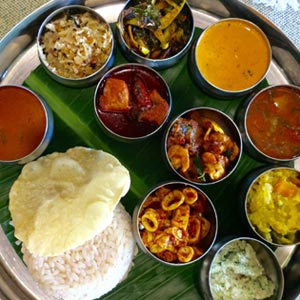
(Left) A mouthwatering destination for foodies. Seafood Thali.
While listening to melodious tabla and flute played by live performers, I feast on my first Kerala meal of fresh grilled seafood, fragrant meat stews, appam (fermented rice pancakes), and a dozen homemade pickles from vegetables picked at the resort’s organic gardens. Abundant with spices, the cuisine of Kerala includes a wide assortment of vegetarian and non-vegetarian dishes flavored with chilies, mustard seeds, coconut oil, curry leaves, and ghee. Most ingredients are grown locally, if not in people’s own backyard gardens. Even the spices and oils are harvested from neighboring villages, ensuring quality and freshness. The “50 Mile Diet” is a reality here as most meals are cooked with ingredients sourced within 50 miles of the resorts.
The next day, I wake up at the crack of dawn to stroll on a secluded beach, gazing at the power waves of the Arabian Sea, and to practice a few of my asanas with the very flexible resident yogi. Yoga is an essential part of the mind-body restoration and practically all resorts offer free yoga lessons.
After a breakfast of freshly made dosas, it is time to explore the neighboring town of Alleppey, popularly known as “Venice of the East” due to its intricate network of canals.
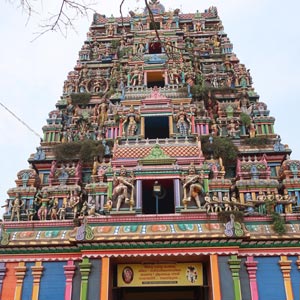
(Right) A Hindu temple in Alleppey.
Alleppey—or Alapuzha as it has been renamed—is a great place to see the harmonious religious diversity of Kerala. It is believed that Christianity came to Kerala in the first century. Kerala is now home to the largest population of Christians in India. At Christ the King Church, I see statues of Jesus decorated with money garlands just like you would at a Hindu temple. Just next door, one can hear the Muslim call to prayer. There are a few Hindu and Jain temples around Alleppey that are also worth visiting. Colorful painted wood, stone, and metals are used to create multiple-storeyed pyramid style structures and compound walls.
I walk through the grand entrance (rajagopuram) and go in barefoot to pay my respects to the Gods at the majestic Kidangamparambu Sree Bhuvaneswari Temple. There is a feast, festival, or celebration taking place throughout the year, with processions and offerings at the temples and churches. Common to all religious communities is the harvest festival of Onam, which takes place for 10 days sometime in August-September.
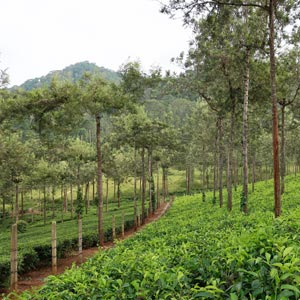
(Left) Usually there is a clash between commerce and natural beauty, since development cuts into the latter. The lush green landscapes of tea plantations, however, translate to great commerce as well.
I continue my journey, heading inland on a winding road through lush green cardamom hills and terraced tea plantations to the hill station of Thekkady. Many of the tea factories in the area offer tours and tastings, so I stop to pick up packets of green and black teas at wholesale prices. The small town of Thekkady is densely packed with spice shops selling freshly dried cinnamon, nutmeg, cardamom, black pepper, vanilla, and nuts. Nearby, there is a cardamom (elaichi) sorting factory and the largest cardamom auction house in the world. The aromatic seeds were first commercialized by the British who developed plantations, and India is now the biggest producer of cardamom in the world. It is hard not to stock up for the year on high quality spices sold at a fraction of store prices!
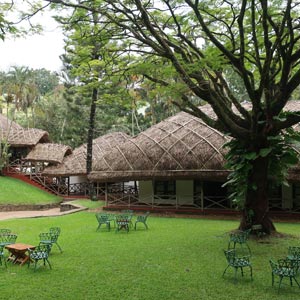
(Right) Spice Village, the author’s lodging in Thekkady.
My lodging in Thekkady is aptly named, Spice Village, and is the oldest mountain village-style resort in the area. Surrounded by hills and backed by forest, the cottages are spaced around spice trees. A naturalist takes me around the property to introduce me to the variety of flora, and the monkeys and birds that hang around the cottages. Keeping true to Kerala’s eco-friendly nature, the resort grows its own food, filters and bottles its own water, composts food waste, harnesses solar energy, and even makes its own paper. Local culture is also intricately tied into the visitor experience. In the evening, guests gather in the community hall to watch live performances of Bharatanatyam and Mohiniyattam before retiring to Woodhouse Bar for a nightcap. The former home of forest ranger Mr. A. W. Woods is converted into a British-style pub with old black and white photos, antiques, and a 150-year-old billiards table.
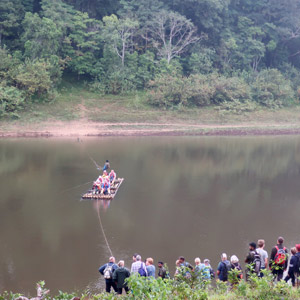
(Left) Crossing the river by old-fashioned rafts, to get to the Periyar Tiger Reserve.
We watch an exciting slideshow at the Interpretation Center – Tiger Club located at Spice Village, thrilled at the prospect of encountering tigers and elephants in the wild. Dressed in camouflage, leech-proof socks, and walking boots, I make my way to Periyar Tiger Reserve on a bus, then cross the river on an old-fashioned bamboo raft, and finally set foot into the forest. After a few hours of trekking through the serene sanctuary set in the mountainous Western Ghats, my ranger and I only see some wild dogs, giant squirrels, deer, langur, macaque, and mongoose. “Chances of seeing a tiger are very rare!” he informs me, though evidence of sighting exists in pictures back at the Tiger Club.
One cannot come to Kerala and not experience the backwaters, one of the most popular tourist destinations in India. Kerala backwaters are made up of five lakes and 38 rivers, linked by canals. The backwaters are an important part of Kerala’s infrastructure as they provide water for irrigation, access for transporting rice, and environment for aquatic life. Kumarakom, located on the banks of the Vembanad Lake is my next stop. Many people come here to rent a houseboat or ketuvallam and cruise on the waters for a night, enjoying the cool breeze and eating fresh catch. Watching the architecture and design of the traditional Kerala houseboats is charming as you see these floating homes (equipped with beds and restrooms) make their way through coconut groves, water hyacinth ponds, and rice paddies.
I decide to stay at Coconut Lagoon, a heritage hotel located by India’s longest lake. Accessible only by boat, a water taxi brings me to the reception of the hotel, which is intertwined by lagoons and bridges. Each of the buildings is made of wood salvaged from historic homes from all over Kerala and reassembled on the property. The inside of the room looks like an intricately carved wooden houseboat. With spectacular views of the lake, rice paddies, gardens, and a bird sanctuary, it is hard not to feel completely relaxed.
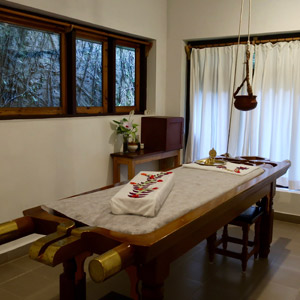 (Right) Kerala is a popular destination for Ayurvedic massages, and detox and rejuvenation retreats.
(Right) Kerala is a popular destination for Ayurvedic massages, and detox and rejuvenation retreats.
If the scenery and organic food is not enough to comfort the senses, two Ayurvedic doctors (known as vaids) are available at the spa to diagnose and treat common ailments. Ayurveda is one of the oldest medicinal practices in the world and widely followed in Kerala. It is believed that the wet temperate climate, abundance of medicinal plants, and an abundance of Ayurveda colleges and researchers make Kerala an ideal place to consistently experience the benefits of Ayurveda. After a brief conversation with my doctor and diagnosis of my vata, pitta, and kapha, I am advised to get a four hands massage to help with my stiff neck and shoulder aches. Using a mixture of essential oils and extracts, two ladies gently rub the liquid in circular motion to release tension and relax my muscles.
To end the day, a local lady known simply as “Amma” pulls in her canoe to serve chai and snacks to the guests staying at the resort. She skillfully ribbons her homemade masala tea from one steel cup to another offering a magical show of sorts that entertains kids and adults. We sit on the green lawn, sipping on hot tea and gaze out at the calm waters. Being in Kerala for a week has slowed me down and infused the sense of tranquility that every vacationer seeks.
~ Written for Khabar Magazine. February 2018.